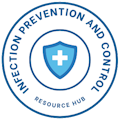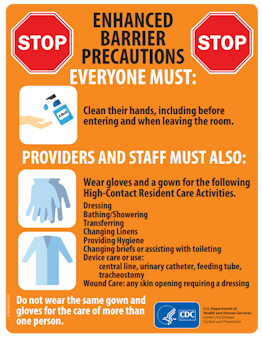
Enhanced Barrier Precautions

Enhanced Barrier Precautions
Residents in nursing homes are at increased risk of becoming colonized with or developing infections caused by multidrug resistant organisms (MDROs). Studies show that more than 50% of nursing home residents may be colonized with an MDRO, and when MDROs result in infection, limited treatment options may be available. Enhanced Barrier Precautions (EBP) expand the use of personal protective equipment (PPE) to include the use of gown and gloves during high-contact resident care activities -- activities that provide opportunities for the transfer of MDROs to staff hands and clothing. MDROs may be indirectly transferred from resident-to-resident during these high-contact care activities.
EBP require staff to wear a gown and gloves while performing high-contact care activities with all residents who are at higher risk of acquiring or transmitting an MDRO.
This includes:
- Residents known to be infected or colonized with an MDRO;
- Residents with an indwelling medical device including central venous catheter, urinary catheter, feeding tube (PEG tube, G-tube), tracheostomy/ventilator regardless of their MDRO status; and,
- Residents with a chronic wound, regardless of their MDRO status
CMS recently issued guidance indicating that EBP will be incorporated into F880 Infection Prevention and Control, effective April 1, 2024.
Numerous resources are available from MDPH and CDC to assist facilities with EBP implementation:
CDC Resources
- CDC EBP website: Implementation of Personal Protective Equipment (PPE) Use in Nursing Homes to Prevent Spread of Multidrug-resistant Organisms (MDROs)
- CDC EBP Pre-Implementation Tool
- CDC EBP Observations Tool
- CDC EBP Letter to Nursing Home Staff
- CDC EBP Letter to Residents, Families, Friends and Volunteers
- CDC Frequently Asked Questions (FAQs) about Enhanced Barrier Precautions in Nursing Homes
- CDC EBP Signage: English & Spanish
- CDC video: Enhanced Barrier Precautions in Nursing Homes (youtube.com)
- CDC video (Spanish): Precauciones Mejoradas de Barrera en Residencias de Ancianos (youtube.com)
MDPH Resources
- MDPH EBP Quick Reference Guide
- MDPH EBP 101 and EBP 201 webinars
- MDPH MDRO Toolkit
Other Resources
In Massachusetts, EBP is indicated for the following organisms:
Targeted MDROS:
- Pan-resistant Organisms
- Carbapenem-resistant Acinetobacter baumannii (CRAB)
- Carbapenem-resistant Enterobacterales (CRE)
- Carbapenem-resistant Pseudomonas aeruginosa (CRPA)
- Carbapenemase-producing Organisms (CPO)
- Candida auris
Epidemiologically Important MDROs including but not limited to:
- Methicillin-resistant Staphylococcus aureus (MRSA)
- ESBL-producing Enterobacterales
- Vancomycin-resistant Enterococci (VRE)
- Multi-drug-resistant Pseudomonas aeruginosa
- Drug-resistant Streptococcus pneumoniae